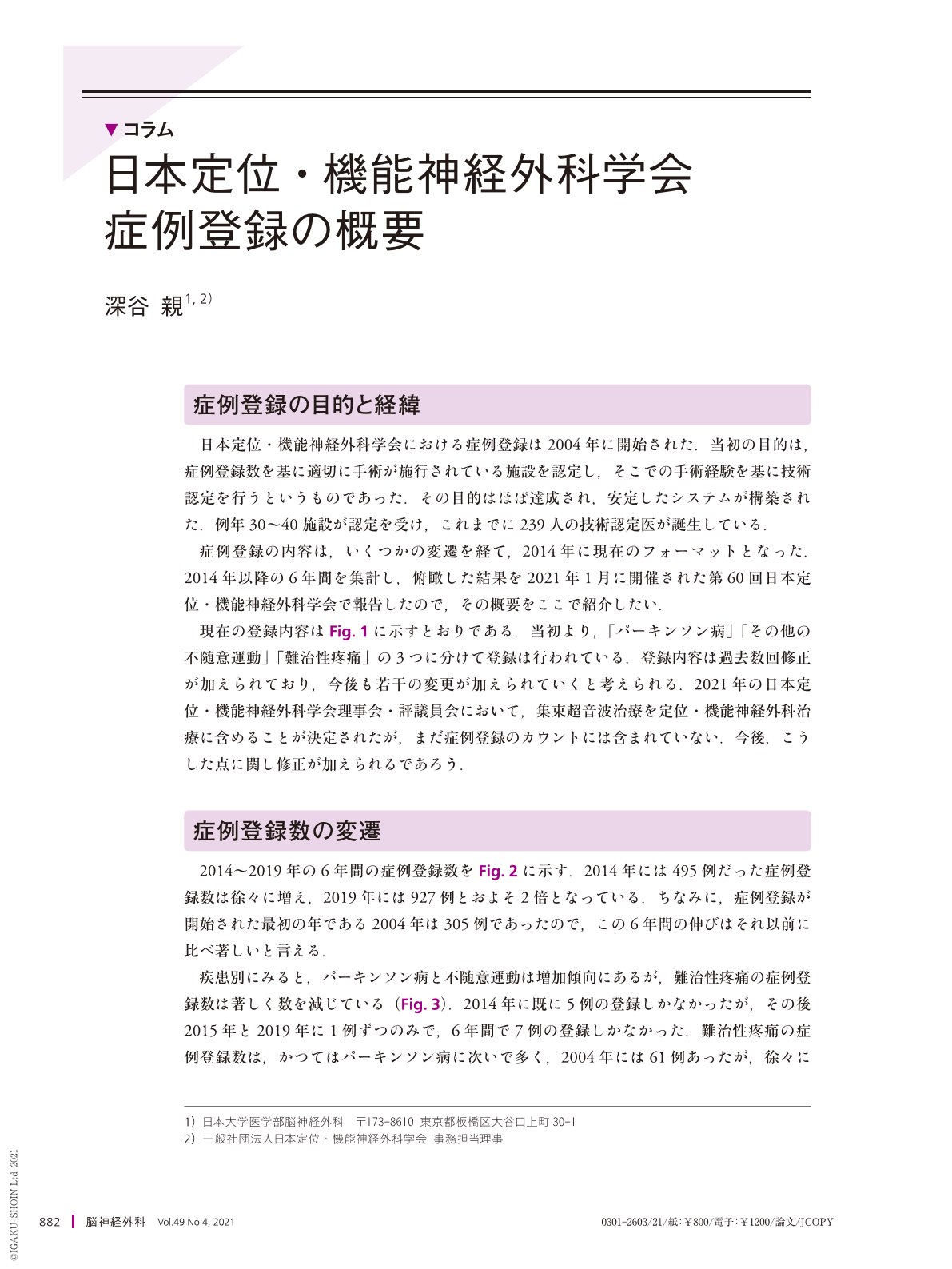1 0 0 0 OA 遷延性意識障害に対する脳脊髄刺激療法
- 著者
- 山本 隆充 深谷 親 吉野 篤緒 片山 容一
- 出版者
- 日本大学医学会
- 雑誌
- 日大医学雑誌 (ISSN:00290424)
- 巻号頁・発行日
- vol.73, no.2, pp.109-111, 2014-04-01 (Released:2015-05-22)
- 参考文献数
- 14
要旨 遷延性意識障害では,vegetative state (VS) とminimally conscious state (MCS) を明確に区別する必要がある.VS には視床CM-pf complex をターゲットとする脳深部刺激療法,MCS には上位頚髄刺激療法を用いてきた.視床CM-pf complex 刺激では,大脳皮質への広範投射系を賦活することにより,刺激開始直後から激しい覚醒反応と脳血流の増加を認める.また,5 Hz の上位頚髄刺激では上肢のmuscle twitch を誘発し,脳血流を増加させる.手術適応を決定するためには残存する脳機能を正確に評価する必要があり,神経学的評価と電気生理学的評価が有用である.VS は脳深部刺激療法によって植物状態から脱却してもベッド上生活であったが,上位脊髄刺激によってMCS から回復した症例では運動機能の回復も良好で,特に上肢の運動機能回復が著しかった.脊髄刺激によって繰り返しmuscle twitch を誘発することは,関節拘縮や筋の廃用性萎縮を予防するとともに,運動機能回復に有用であり,新たなニューロモデュレーション技術として期待される.
1 0 0 0 日本定位・機能神経外科学会症例登録の概要
症例登録の目的と経緯 日本定位・機能神経外科学会における症例登録は2004年に開始された.当初の目的は,症例登録数を基に適切に手術が施行されている施設を認定し,そこでの手術経験を基に技術認定を行うというものであった.その目的はほぼ達成され,安定したシステムが構築された.例年30〜40施設が認定を受け,これまでに239人の技術認定医が誕生している. 症例登録の内容は,いくつかの変遷を経て,2014年に現在のフォーマットとなった.2014年以降の6年間を集計し,俯瞰した結果を2021年1月に開催された第60回日本定位・機能神経外科学会で報告したので,その概要をここで紹介したい.
1 0 0 0 OA 言語聴覚療法
1 0 0 0 OA Neuromodulation
- 著者
- 深谷 親 山本 隆充
- 出版者
- 日本脳神経外科コングレス
- 雑誌
- 脳神経外科ジャーナル (ISSN:0917950X)
- 巻号頁・発行日
- vol.25, no.2, pp.137-142, 2016 (Released:2016-02-25)
- 参考文献数
- 20
機能的神経疾患の原因を考えるうえで皮質-線条体-視床-皮質ループ (CSTCループ) という概念が注目されている. 大脳皮質から大脳基底核, 視床に至る経路にそれぞれ運動, 認知, 情動に関する回路が近接して存在し, 連携して活動しているという考えである. このループの機能障害が関与していると考えられる疾患として, パーキンソン病, ジストニア, 強迫性障害, トゥレット症候群などが挙げられる. これらの疾患では, 運動, 認知, 情動のどの回路が主に障害されているかで疾病としての表現型も異なってくる. 脳深部刺激療法のターゲットは, CSTCループのいずれかの部位に設定されることが多い. したがって, 運動, 認知, 情動といった機能を個々に切り離して治療することは難しい. パーキンソン病に対する視床下核の刺激により情動面の変化が生じることがあるのはよく知られている. こうした現象は, 健常者においても気分のよいときには行動も快活になり, 気分が落ち込んでいる時は頭も働かなくなるといった経験からも理解できるであろう. CSTCループを基盤とした考えは, 脳深部刺激療法の理論背景となるだけではなく, 最前線の臨床の場でも役立つ可能性が高い. 運動には, 高い認知症予防効果やうつの改善効果があり, パーキンソン病の進行を遅らせることが知られている. また前向きで安定した情動は不随意運動を改善し, 運動療法が痛み認知を改善させることも報告されている.
1 0 0 0 OA 振戦に対する視床手術 : 凝固術と脳深部刺激療法のための手術とではどう違うか
- 著者
- 深谷 親 片山 容一
- 出版者
- 日本脳神経外科コングレス
- 雑誌
- 脳神経外科ジャーナル (ISSN:0917950X)
- 巻号頁・発行日
- vol.13, no.5, pp.347-352, 2004-05-20 (Released:2017-06-02)
- 参考文献数
- 17
- 被引用文献数
- 1
凝固術においては,最少の副作用で最大の効果が得られる最適の標的部位を限局性に特定することが,その基本的な戦略となる.しかし,脳深部刺激療法(deep brain stimulation : DBS)では,必要な範囲の刺激が行えるように電極を配置することが基本的な戦略である.この戦略では,最適な部位が限局性に存在するという前提は必要とならない.したがって,凝固術とDBSでは異なる工夫が必要となる.振戦に対する凝固術では,主として視床腹中間核の腹外側部が最適の標的部位とされてきた.これに対し,振戦に対するDBSでは,視床腹吻側核から腹中間核にわたる広い範囲の刺激ができるように電極を配置したほうが,良好な効果が得られる.そのためには(1)前後方向では,DBS電極をあまり垂直にしない,(2)内外方向では,DBS電極をあまり外方に傾けない,(3) dual-leadDBSを活用する,などの工夫をすることが重要である.
1 0 0 0 脳深部刺激療法によるパーキンソン病の治療(<特集>脳と医科器械)
1 0 0 0 OA 脳内埋め込み電極と体内埋設型刺激デバイスを用いた不随意運動の治療
- 著者
- 片山 容一 深谷 親
- 出版者
- 一般社団法人 日本めまい平衡医学会
- 雑誌
- Equilibrium Research (ISSN:03855716)
- 巻号頁・発行日
- vol.67, no.1, pp.65-71, 2008 (Released:2008-05-02)
- 参考文献数
- 20
In an attempt to control hypokinetic and hyperkinetic movement disorders, deep brain stimulation (DBS) has been developed during the last two decades by several investigators. In 1987, Benabid and his colleagues suggested the usefulness of high-frequency stimulation of the ventral intermediate nucleus of the thalamus for treating drug-resistant tremors and avoiding the adverse effects of thalamotomy. Since then, DBS has been used as an alternative to functional neurosurgery for movement disorders, and more recently, it has been applied to the treatment of epilepsy, obsessive-compulsive disorders and cluster headache, in addition to other applications in experimental models. In regard to the treatment of movement disorders, recent clinical studies have demonstrated that DBS affords great benefits in terms of improvement of the activities of daily living in patients with Parkinson's disease (PD), essential tremor, dystonia and poststroke hyperkinetic movement disorders. We have treated patients with movement disorders by DBS of the thalamic nuclei ventralis oralis (Voa/Vop) et intermedius (Vim), globus pallidus internus (GPi), and subthalamic nucleus (STN). The site of permanent electrode placement was identified using magnetic resonance imaging and multiunit extracellular recording. The implantable pulse generator was internalized after postoperative test stimulation for one week. The stimulation parameters were modified by physicians at each follow-up visit on the basis of the findings on neurological examination, as well as the patient's report concerning the activities of daily living. The advantages of DBS include reversibility and controllability of stimulation. In addition, DBS carries a smaller risk of side effects, particularly when employed bilaterally. Thalamic DBS is useful for controlling tremor that is unresponsive to medication. DBS of the STN and GPi improves the motor functions in PD patients, mainly during the off-period. Moreover, STN-DBS attenuates levodopa-induced dyskinesia through reducing the requirement of DOPA, whereas GPi-DBS directly attenuates DOPA-induced dyskinesia. In addition, GPi-DBS is very useful for controlling the symptoms of idiopatic generalized dystonia. According to reports, DBS is associated with few serious adverse effects associated with DBS. In general, the operative mortality is less than 1%. The incidences of hemorrhage are in the range of about 1-6%, and the incidences of device-related complications, such as infection or skin erosion, are in the range of 3-26%. DBS is clinically effective in well-selected patients and should be considered as a treatment option for patients with medically refractory movement disorders. Despite its clinical usefulness, the mechanism underlying the efficacy of DBS is still unclear. There is no proof currently that long-term DBS can reset neural networks or induce profound modifications of functional organization. Several researchers have proposed hypotheses concerning the mechanism underlying the efficacy of DBS, including 1) jamming of neural transmission, 2) direct inhibition of spike initiation at the level of the membrane that may be due to the activation of inhibitory terminals, 3) functional changes due to a decrease or increase in the amount of neurotransmitter released, and 4) retrograde activation of upstream neural structures. From the viewpoint of basic neuroscience, the development of DBS is intriguing. Investigation regarding the mechanism underlying the efficacy of DBS may provide clues for further clarification of various processes in the central nervous system.

